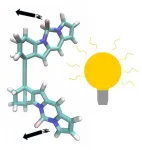University of Groningen scientists design superfast molecular motor
2021-06-17
(Press-News.org) Light-driven molecular motors have been around for over twenty years. These motors typically take microseconds to nanoseconds for one revolution. Thomas Jansen, associate professor of physics at the University of Groningen, and Master's student Atreya Majumdar have now designed an even faster molecular motor. The new design is driven by light only and can make a full turn in picoseconds, using the power of a single photon. Jansen: 'We have developed a new out-of-the-box design for a motor molecule that is much faster.' The design was published in The Journal of Physical Chemistry Letters on 7 June.
The new motor molecule design started with a project in which Jansen wanted to understand the energy landscape of excited chromophores. 'These chromophores can attract or repel each other. I wondered if we could use this to make them do something', explains Jansen. He gave the project to Atreya Majumdar, then a first-year student in the Top Master's degree programme in Nanoscience in Groningen. Majumdar simulated the interaction between two chromophores that were connected to form a single molecule.
Light
Majumdar, who is now a PhD student in nanoscience at the Université Paris-Saclay in France, explains what he found: 'A single photon will excite both chromophores simultaneously, creating dipoles that make them repel each other.' But as they are stuck together, connected by a triple bond axis, the two halves push each other away around the axis. 'During this movement, they start to attract each other.' Together, this results in a full rotation, generated by the light energy and the electrostatic communication between the two chromophores.
The original light-driven molecular motor was developed by Jansen's colleague Ben Feringa, Professor of Organic Chemistry at the University of Groningen and recipient of the 2016 Nobel Prize for Chemistry. This motor makes one revolution in four steps. Two steps are driven by light and two are driven by heat. 'The heat steps are rate-limiting,' explains Jansen. 'The molecule has to wait for a fluctuation in heat energy to drive it to the next step.'
Bottlenecks
By contrast, in the new design, a rotation is fully downhill from an excited state. And as - due to the laws of quantum dynamics - one photon excites both chromophores simultaneously, there are no major bottlenecks to limit the speed of rotation, which is therefore two to three orders of magnitude greater than that of the classic 'Feringa' motors.
All of this is still theoretical, based on calculations and simulations. 'Building one of these motors is not trivial', acknowledges Jansen. The chromophores are widely used but slightly fragile. Creating a triple bond axis is also not easy. Jansen expects that someone will try to build this organic molecule now that its properties have been described. And it is not one specific molecule that has these properties, adds Majumdar: 'We have created a general guide for the design of this type of molecular motor.'
Blueprint
As for applications, Jansen can think of a handful. They might be used to power drug delivery or move nanoscale objects on a surface, or they might be used in other nanotech applications. And the rotational speed is well above that of the average biophysical process, so it may be used to control biological processes. In the simulations, the motors were attached to a surface but they will also rotate in solution. Jansen: 'It will require a lot of engineering and tweaking to realize these motors but our blueprint will deliver a brand-new type of molecular motor.'
INFORMATION:
Reference: Atreya Majumdar and Thomas L. C. Jansen: Quantum-Classical Simulation of Molecular Motors Driven Only by Light. The Journal of Physical Chemistry Letters, online 7 June 2021.
[Attachments] See images for this press release:

ELSE PRESS RELEASES FROM THIS DATE:
2021-06-17
When astronomers using NASA's Hubble Space Telescope uncovered an oddball galaxy that looked like it didn't have much dark matter, some thought the finding was hard to believe and looked for a simpler explanation.
Dark matter, after all, is the invisible glue that makes up the bulk of the universe's matter. All galaxies appear to be dominated by it; in fact, galaxies are thought to form inside immense halos of dark matter.
So, finding a galaxy lacking the invisible stuff is an extraordinary claim that challenges conventional wisdom. It would have the potential to upset theories of galaxy formation and evolution.
To bolster their original finding, first reported in 2018 ...
2021-06-17
The intestinal disease necrotizing enterocolitis is a leading cause of death among premature infants born in the U.S. and across the globe. Characterized by excessive inflammation that can cause tissue decay in the bowels, the disease provides a pathway for infectious and deadly bacteria to enter the bloodstream.
Despite four decades of research, effective treatments remain elusive, and mortality rates in babies who develop the disease have remained essentially unchanged, hovering at about 30%.
Now, a study led by researchers at Washington University ...
2021-06-17
Personalised coaching through a smartphone platform can help women improve their lifestyle behaviours in the period before and shortly after they become pregnant, a new study has shown. The biggest reduction in behaviours that pose risks to pregnancy were seen in overweight women.
The findings, published in the journal Reproductive Biomedicine Online, show that digital healthcare could be a cost-effective way to deliver tailored advice to women who experience difficulties in pregnancy, which the NHS does not have the resources to provide.
In this study, led by the University of Southampton, 262 women who were planning pregnancies and had either experienced difficulties in conceiving or recurrent miscarriages signed ...
2021-06-17
June 17, 2021 - Nutley, NJ - Tiny genetic markers, circulating in the blood, have shown great promise in diagnosing and treating disease. Yet identifying and harvesting these extracellular vesicles (EVs) have been a major challenge for science.
Now a laboratory at the Hackensack Meridian Center for Discovery and Innovation (CDI) has discovered a highly sensitive methodology that can efficiently find and harness EVs - particularly exosomes and the micro RNAs they carry. These could be crucial clues to identifying diseases such as cancer early on in its development.
The scientists have now unveiled the Extracellular Vesicle Capture by AnTibody of CHoice and 1 Enzymatic Release, or EV-CATCHER, in the Journal of Extracellular Vesicles.
"We are establishing the threshold ...
2021-06-17
TAMPA, Fla. (June 17, 2021) - Tests that analyze biomarkers are used during cancer management to guide treatment and provide information about patient prognosis. These tests are often performed on tissue biopsy samples that require invasive procedures and can lead to significant side effects. In a new article published in the Journal for ImmunoTherapy of Cancer, Moffitt Cancer Center researchers show that PET/CT images can be used to measure levels of the PD-L1 biomarker of non-small cell lung cancer (NSCLC) patients in a non-invasive manner and, in turn, predict a patient's response to therapy. ...
2021-06-17
As pandemic restrictions begin to loosen around the country and summer temperatures rise, more people will be moving about on public rideshare electric scooters. With that comes this warning: Ride with safety.
A Henry Ford Health System study published in The Laryngoscope, shows that head and neck injuries caused by use of e-scooters have been on the rise since rideshare systems were introduced to the public in late 2017.
Kathleen Yaremchuk, M.D., Chair of the Department of Otolaryngology - Head and Neck Surgery and the study's senior author, said that a review of emergency visits in the last three years showed e-scooter injuries have increased significantly with many related to head and neck injuries. "Since e-scooters became a popular form of ...
2021-06-17
In the Name of Racial Justice: Why Bioethics Should Care about Environmental Toxins
Keisha Ray
Facilities that emit hazardous toxins, such as toxic landfills, oil refineries, and chemical plants, are disproportionately located in predominantly Black, Latinx, and Indigenous neighborhoods. Environmental injustices like these threaten just distribution of health itself. Facilities that emit environmental toxins wrongly make people's race, ethnicity, income, and neighborhood essential to who is allowed to breathe clean air and drink clean water, and thus, who is allowed to be healthy. This ...
2021-06-17
A large, retrospective, multicenter study involving Washington University School of Medicine in St. Louis indicates that convalescent plasma from recovered COVID-19 patients can dramatically improve likelihood of survival among blood cancer patients hospitalized with the virus.
The therapy involves transfusing plasma -- the pale yellow liquid in blood that is rich in antibodies -- from people who have recovered from COVID-19 into patients who have leukemia, lymphoma or other blood cancers and are hospitalized with the viral infection. The goal is to accelerate their disease-fighting response. Cancer patients may be at a higher risk of death related to COVID-19 because of their weakened immune systems.
The data, collected as part ...
2021-06-17
A new article, published as a Perspective in the journal Conservation Science and Practice, introduces a rapid assessment framework that can be used as a guide to make conservation and nature-based solutions more robust to future climate.
Climate change poses risks to conservation efforts, if practitioners assume a future climate similar to the past or present. For example, more frequent and intense disturbances, such as wildfire or drought-induced tree mortality, can threaten projects that are designed to enhance habitat for forest-dependent species and sequester carbon. Overlooking such climate-related risks can result in failed conservation investments and negative outcomes for people, biodiversity, and ecosystem integrity as well as lead to carbon-sink reversal. Drawing ...
2021-06-17
The Black Sea is an unusual body of water: below a depth of 150 metres the dissolved oxygen concentration sinks to around zero, meaning that higher life forms such as plants and animals cannot exist in these areas. At the same time, this semi-enclosed sea stores comparatively large amounts of organic carbon. A team of researchers led by Dr Gonzalo V. Gomez-Saez and Dr Jutta Niggemann from the University of Oldenburg's Institute for Chemistry and Biology of the Marine Environment (ICBM) has now presented a new hypothesis as to why organic compounds accumulate in the depths of the Black Sea - and other oxygen-depleted waters in the scientific journal Science Advances.
The researchers posit that reactions with hydrogen sulfide play an important role in stabilizing ...
LAST 30 PRESS RELEASES:
[Press-News.org] University of Groningen scientists design superfast molecular motor






